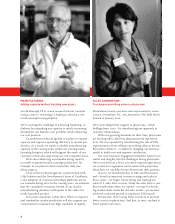Eli Lilly 2011 Annual Report Download - page 20
Download and view the complete annual report
Please find page 20 of the 2011 Eli Lilly annual report below. You can navigate through the pages in the report by either clicking on the pages listed below, or by using the keyword search tool below to find specific information within the annual report.
FORM 10-K
processes do not preclude other manufacturers from employing alternative processes or marketing alternative
products or formulations that compete with our patented products. In addition, competitors or other third parties
sometimes may assert claims that our activities infringe patents or other intellectual property rights held by them,
or allege a third-party right of ownership in our existing intellectual property.
Our Intellectual Property Portfolio
We consider intellectual property protection for certain products, processes, and uses—particularly those products
discussed below—to be important to our operations. For many of our products, in addition to the compound patent
we hold other patents on manufacturing processes, formulations, or uses that may extend exclusivity beyond the
expiration of the product patent.
The most relevant U.S. patent protection or data package protection for our larger or recently launched patent-
protected marketed products is as follows:
•Alimta is protected by a compound patent (2016), as extended by pediatric exclusivity (2017), and a concomitant
nutritional supplement use patent (2021), as extended by pediatric exclusivity (2022).
•Cialis is protected by compound and use patents (2017).
•Cymbalta is protected by a compound patent (June 2013). We are seeking pediatric exclusivity which, if granted,
would extend protection to December 2013.
•Effient is protected by a compound patent (2017).
•Evista is protected by patents on the treatment and prevention of osteoporosis (2014). Evista for use in breast
cancer risk reduction is protected by orphan drug exclusivity (2014).
•Humalog is protected by a compound patent (May 2013).
•Strattera is protected by a patent covering its use in treating attention deficit-hyperactivity disorder (2016), as
extended by pediatric exclusivity (2017).
•Tradjenta is protected by a compound patent (2023), and Boehringer Ingelheim has applied for a patent
extension to 2025 under the patent restoration laws.
U.S. patent protection or data package protection for our new molecular entities that have been submitted for
regulatory review is as follows. Additional information about these molecules is provided in Item 7, Management’s
Discussion and Analysis under “Late Stage Pipeline.” The dates below do not include any potential patent extensions
or adjustments as described above:
•Florbetapir is covered by a compound patent (2025).
•Liprotamase is expected to be protected for at least the five-year data package protection period following U.S.
regulatory approval.
Worldwide, we sell all of our major products under trademarks that we consider in the aggregate to be important to
our operations. Trademark protection varies throughout the world, with protection continuing in some countries as
long as the mark is used, and in other countries as long as it is registered. Registrations are normally for fixed but
renewable terms.
Patent Licenses
Most of our major products were discovered in our own laboratories and are not subject to significant license
agreements. Two of our larger products, Cialis and Alimta, are subject to patent assignments or licenses granted to
us by others.
• The compound patent for Cialis is the subject of a license agreement with Glaxo SmithKline which assigns to us
exclusively all rights in the compound. The agreement calls for royalties of a single-digit percentage of net
sales. The agreement is not subject to termination by Glaxo for any reason other than a material breach by Lilly
of the royalty obligation, after a substantial cure period.
• The compound patent for Alimta is the subject of a license agreement with Princeton University, granting us an
irrevocable exclusive worldwide license to the compound patents for the lives of the patents in the respective
territories. The agreement calls for royalties of a single-digit percentage of net sales. The agreement is not
subject to termination by Princeton for any reason other than a material breach by Lilly of the royalty obligation,
after a substantial cure period. Alimta is also the subject of a worldwide, nonexclusive license to certain
compound and process patents owned by Takeda Pharmaceutical Company Limited. The agreement calls for
royalties of a single-digit percentage of net sales in countries covered by a relevant patent. The agreement is
subject to termination for material default and failure to cure by Lilly and in the event that Lilly becomes
bankrupt or insolvent.
Patent Challenges
In the U.S., the Drug Price Competition and Patent Term Restoration Act of 1984, commonly known as “Hatch-
Waxman,” made a complex set of changes to both patent and new-drug-approval laws. Before Hatch-Waxman, no
drug could be approved without providing the FDA complete safety and efficacy studies, i.e., a complete New Drug
Application (NDA). Hatch-Waxman authorizes the FDA to approve generic versions of innovative pharmaceuticals
(other than biologics) without such information by filing an Abbreviated New Drug Application (ANDA). In an ANDA,
the generic manufacturer must demonstrate only “bioequivalence” between the generic version and the
NDA-approved drug—not safety and efficacy.
6
























